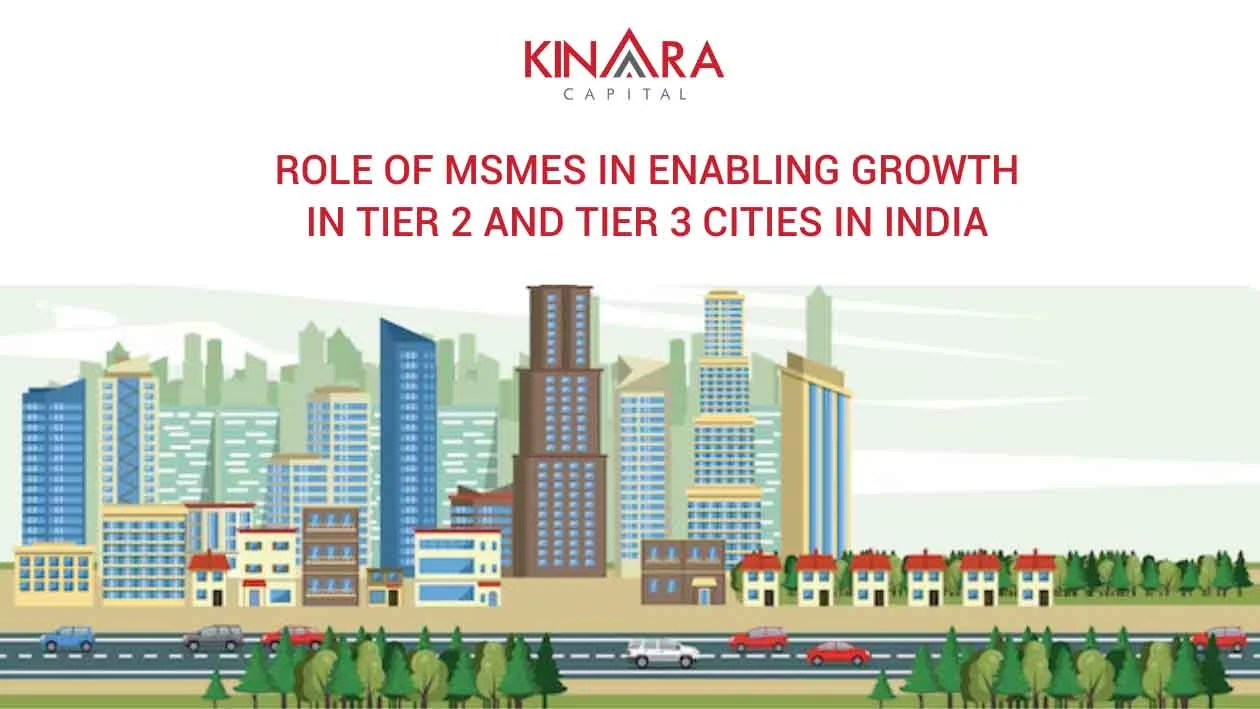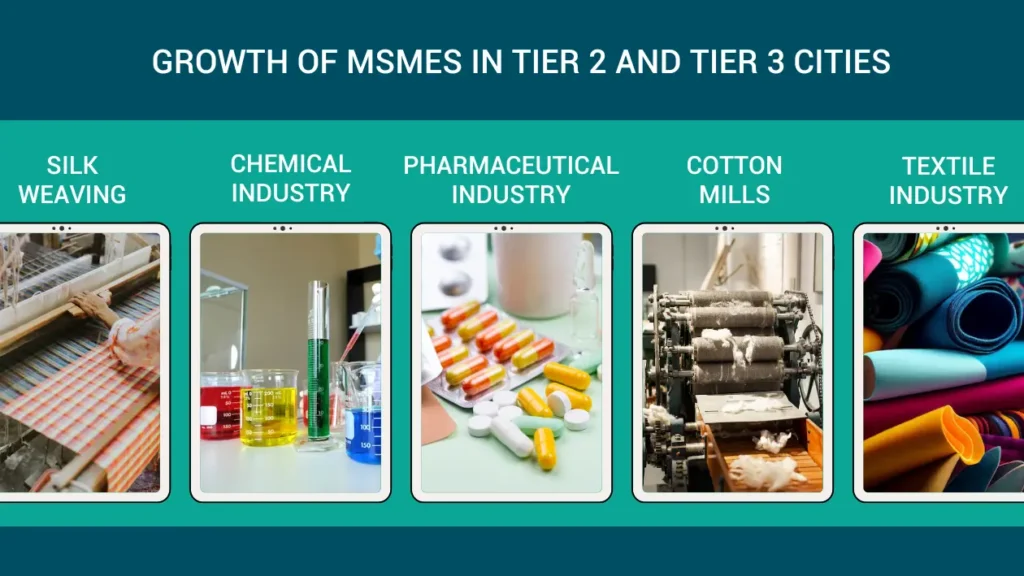
Micro, Small, and Medium Enterprises (MSMEs) are vital contributors to India’s economy, playing a significant role in job creation, innovation, and overall economic growth. With a wide presence across the nation, MSMEs fuel entrepreneurial spirit and contribute to the socio-economic fabric of the country. These enterprises are key drivers of employment generation, fostering innovation, and ensuring inclusive development. As engines of economic growth, MSMEs in India play a crucial role in driving productivity. The sector promotes entrepreneurship and contributes 30% of the nation’s GDP and nearly 50% to Indian Exports.
Recognising MSMEs immense potential and impact is essential for creating a thriving business ecosystem in India. MSME Day is an international initiative dedicated to recognising and promoting the contributions of MSMEs in fostering sustainable development and inclusive growth. Celebrated on the 27th of June, MSME Day provides a platform for MSMEs to raise awareness about the unique challenges, celebrate their accomplishments, and advocate for supportive policies and programs.
This year, it is important to spotlight the thriving MSME ecosystem flourishing within Tier 2 and Tier 3 cities in India, exploring their transformative potential for the nation’s economic advancement. It is a momentous opportunity to illuminate the exceptional potential and impact of these enterprises. Tier 2 and Tier 3 cities denote cities with a population in the range of 50,000 – 100,000 and 20,000 to 50,000. By amplifying their impact and empowering their growth, the country can unleash the full potential of MSMEs in driving India towards a prosperous future.
In recent years, India’s Tier 2 and Tier 3 cities have experienced a remarkable transformation, emerging as vibrant hubs for entrepreneurial activities. According to the Ministry of Commerce and Industry, around 50% of the recognised startup in India are now from Tier 2 and Tier 2 cities. Apart from that, nowadays, several companies in Tier 1 are interested in locating to Tier 2 or Tier 3 cities. The reason behind this is mostly because of the comparatively cheap labour and affordable real estate, but setting up in these cities also comes with challenges. These challenges lead them difficult to access the resources they need to move their business forward. Some of those challenges include
The infrastructure in Tier 2 and Tier 3 cities are often not as good as in Tier 1 cities. Challenges like inadequate transportation and lack of intercity connectivity can make it difficult for businesses to operate and for people to get around.
Small businesses in Tier 2 and Tier 3 cities often have difficulty accessing capital. This is because banks and other financial institutions are often reluctant to lend money to MSMEs in without collateral. This problem can be worse in Tier 2 and 3 cities because lenders tend to be more conservative and strict about guidelines since these are not as commercially busy as major cities.
The competition in Tier 2 and Tier 3 cities is increasing. This is because more businesses are setting up shop in these cities.
Despite these challenges, the growth in Tier 2 and Tier 3 cities will likely continue in the coming years. The reasons for this growth are strong, and the government is committed to promoting growth in these cities. Some of the reasons for this emerging growth include
The internet and mobile phones have made it easier for businesses to reach customers in Tier 2 and Tier 3 cities. This has led to an increase in e-commerce and other online businesses.
The disposable income of people living in Tier 2 and Tier 3 cities has increased in recent years. This is due to a number of factors, including rising wages, the growth of the informal sector, and the expansion of government programs. Aspirational lifestyles become more widely sought after because of media/social media exposure.
The middle class in India is growing rapidly, and this is having a significant impact on Tier 2 and Tier 3 cities. The middle class is demanding better quality products and services, and this is creating opportunities for businesses in these cities.
Tier 2 and Tier 3 cities have a favourable business environment with lower operating costs and affordable real estate. It also has supportive local administrations that attract aspiring entrepreneurs who seek to minimise their initial investment and operational expenses. Additionally, the improved connectivity infrastructure of these cities has facilitated smoother logistics and supply chains. It makes it easier for MSMEs to operate and expand their reach.
The availability of skilled labour in Tier 2 and Tier 3 cities has driven MSME growth. Many of these cities boast a pool of skilled individuals eager to contribute to the local economy and often willing to work at competitive wages. This availability of skilled manpower has been instrumental in establishing and scaling up various regional businesses.
The demand for goods and services in Tier 2 and Tier 3 cities is growing rapidly. This is due to a number of factors, including the rise of the middle class, the growth of the internet, and the urbanisation of India. Some goods and services in high demand in these cities include consumer electronics, fashion, food and beverage, education, and healthcare. The demand for these goods and services is expected to grow in the coming years, creating new opportunities for businesses looking to expand into these markets.
The government has been taking a number of steps to promote growth in Tier 2 and Tier 3 cities. These include improving infrastructure, providing tax breaks, and investing in education and healthcare. Initiatives such as the “Make in India” campaign, Start-Up India, and Digital India have focused on simplifying business registration processes, providing access to finance and credit facilities, and fostering innovation and technological advancements.
The impact of MSMEs in Tier 2 and Tier 3 cities goes beyond mere economic growth. These enterprises act as catalysts for the development of these cities, creating employment opportunities, reducing migration to urban centres, and improving the overall quality of life. Harnessing local resources and talents can contribute to the socio-economic fabric of their respective regions.
MSMEs in Tier 2 and Tier 3 cities are often involved in sectors such as manufacturing, textiles, agro-based industries, handicrafts, and tourism. They not only leverage traditional skills and knowledge but also embrace innovation and technology to enhance productivity and competitiveness. As a result, these cities become self-sufficient and resilient, reducing their dependency on larger urban centres.
To fully tackle the potential of MSMEs in Tier 2 and Tier 3 cities, providing them with a supportive ecosystem is imperative. This includes access to affordable finance, skill development programs, business incubation centres, and technology adoption. Government schemes like the Credit Guarantee Fund Trust for Micro and Small Enterprises (CGTMSE), the Pradhan Mantri Mudra Yojana (PMMY), and cluster development programs have played a crucial role in fostering an enabling environment for MSMEs.
Cluster development programs are government-led initiatives that aim to promote the growth and development of clusters of MSMEs. These programs typically provide financial assistance, technical support, and training to help SMEs in a particular sector or industry to improve their productivity, competitiveness, and access to markets.
Collaborations between industry associations, educational and skilling institutions, and financial institutions can also create synergies and provide MSMEs with the necessary mentorship, training, and market linkages. Additionally, digital adoption and e-commerce can bridge the gap between MSMEs in Tier 2 and Tier 3 cities and domestic and global markets, expanding their reach and opportunities.

Mysore is located in the Karnataka state of southern India. The city is famous for the pure Mysore silk manufacturing sector. Mysore silk is softer and more expensive because of its higher quality, purity and durability, balancing the costs involved in making it.
MSMEs in Mysore have witnessed recent growth due to a number of factors, including the government’s support for the silk industry, the availability of skilled labour, and the growing demand for Mysore silk products both domestically and internationally. It positively impacted the local economy, created jobs, boosted incomes, and helped preserve the traditional silk industry in the region.
The growing demand for Mysore silk products, both domestically and internationally, is also a major factor contributing to the growth of MSMEs in the region. Mysore silk is known for its high quality and its distinctive golden sheen. This makes it popular for sarees, scarves, and other garments. The Government of Karnataka has provided financial assistance to silk farmers and weavers in the region. It has also set up a number of silk research and development centres to help improve the quality of Mysore silk.
Coimbatore is the second largest city in Tamil Nadu, India. It is known as “the Manchester of South India” due to its cotton production and textile industries. Coimbatore has the largest number of cotton mills in Tamil Nadu and is a major centre for the spinning, weaving, and dyeing of cotton fabrics. The textile industry in Coimbatore is a major contributor to the city’s economy. The first textile mill was set up as far back as 1888. After that, many textile mills were started and provided various employment opportunities within and in neighbouring Districts. The result has been a strong economy and a reputation as one of the greatest industrial cities in South India.
The textile industry in Coimbatore is constantly evolving. The industry is investing in new technologies and is moving towards more sustainable production methods. The industry is also expanding into new markets, such as the export of garments. Coimbatore is a major centre for the textile industry in India. The city has a long and rich history of the industry and is known for its high quality and competitive prices. The industry is constantly evolving and is moving towards more sustainable production methods. Coimbatore is well-positioned to remain a major player in the global textile industry in the future.
Surat is a major industrial city in Gujarat, India. It is known for its textile and diamond cutting & processing industries. The textile industry in Surat is one of the largest and most important in India. It is involved in producing a wide range of textile products, including yarn, fabric, and garments. The industry employs over 2 million people and contributes significantly to the city’s economy. The diamond cutting & processing industry in Surat is also one of the largest in the world. It is involved in the cutting and polishing of rough diamonds into finished jewellery. The industry employs over 1 million people and contributes significantly to the city’s economy.
MSMEs play a vital role in developing Surat’s textile and diamond industries. They are responsible for a significant portion of the production in both industries. MSMEs are also responsible for generating employment and promoting innovation in the region. In recent years, Surat has seen a number of developments in its textile and diamond industries. These include the introduction of new technologies, the expansion of export markets, and the development of new infrastructure. These developments have helped to make Surat a global leader in these industries.
Vishakhapatnam is the largest city in Andhra Pradesh. The pharmaceutical industry in Visakhapatnam is a major contributor to the city’s economy. The industry is home to a number of MSMEs which manufacture a wide range of drugs and other healthcare products. The pharmaceutical industry in Visakhapatnam is constantly evolving, and a number of recent developments are shaping the industry’s future. The city is increasingly focused on innovation as companies seek to develop new drugs and treatments.
The demand for generic drugs is growing, as they are more affordable than branded drugs. This is creating new opportunities for generic drug manufacturers in Visakhapatnam. The pharmaceutical industry is increasingly adopting digital technologies like big data and artificial intelligence. The sector is expected to continue to grow in the coming years as the city attracts more businesses and creates more jobs. Manufacturing is the largest sector in the city, followed by the trading and services sectors.
Thane is a city in Mumbai that is a manufacturing hub with excellent infrastructure facilities. One of the oldest and most important industries in the city is the chemical industry. It has been growing rapidly in recent years and is one of the largest employers. There are a number of factors that have contributed to the growth of the chemical industry in Thane. The city is located in a region that is rich in raw materials, such as coal, petroleum, and salt. These raw materials are essential for the chemical industry.
Thane also has a large pool of skilled labour, which is essential for the chemical industry. The government of Maharashtra has been supportive of the chemical industry in Thane. It has provided a number of incentives to chemical companies, such as tax breaks and land grants. The government has also set up a number of special economic zones (SEZs) for the industry.
MSMEs play an important role in the chemical industry and are increasingly focused on innovation and looking to develop new products and processes. The demand for speciality chemicals is growing, as these chemicals are used in a wide range of industries, such as pharmaceuticals, textiles, and plastics. This is creating new opportunities for chemical manufacturers in Thane.
Tier 2 and Tier 3 cities are growing rapidly. Numerous young entrepreneurs are coming forward to leverage this opportunity. Therefore, there is a huge demand for working capital for MSMEs in these cities to grow their businesses. Seeing the demand, Kinara Capital has opened 133 branches across India, including Tier 2 and Tier 3 cities. Some of those cities include Kalaburagi, Davangere, Tirupur, Ambernath, Vapi Bhavanipuram and Warangal.
Non-banking financial companies (NBFCs) like Kinara Capital are vital in providing funding assistance to MSMEs in Tier 2 and Tier 3 cities. These cities often face challenges in accessing traditional banking channels, and Kinara bridges this gap by offering tailored financial solutions. They provide business loans, working capital financing, and other necessary services to address the unique needs of MSMEs. With their understanding of the local business environment, Kinara offers doorstep customer services, faster loan processing, and minimal documentation. This financial support empowers MSMEs to invest in infrastructure, purchase equipment, and expand their operations.
On this MSME Day, it is crucial to celebrate and acknowledge the entrepreneurial spirit and resilience of MSMEs in Tier 2 and Tier 3 cities in India. These cities represent untapped potential and growing ecosystems that can drive inclusive growth, job creation, and sustainable development. By recognising the vital role played by MSMEs and extending them the required support, we can unlock their full potential and empower the nation’s economic growth from the grassroots.
Through collective efforts, we can foster an environment where every small business in every city thrives and contributes to a prosperous India. As we reflect on the achievements and challenges MSMEs face, let us renew our commitment to nurturing and strengthening the entrepreneurial landscape in Tier 2 and Tier 3 cities, paving the way for a brighter future.
In addition to government initiatives and local support, NBFCs play a significant role in empowering MSMEs in Tier 2 and Tier 3 cities in India. NBFCs support MSMEs in India’s Tier 2 and Tier 3 cities. These institutions offer customised financial solutions that address the funding needs of small businesses. NBFCs provide accessible and flexible financing options, including working capital loans, machinery financing, and trade finance. They have a deep understanding of the local business environment and offer personalised support and guidance to entrepreneurs. Their presence strengthens the ecosystem for entrepreneurship in Tier 2 and Tier 3 cities, contributing to economic growth and development.
To acquire Unsecured Business Loans, small business owners can check their loan eligibility in 1-minute in the myKinara App. After clearing the eligibility criteria, they can upload the required documents on the fully secured portal. Once the documents are verified, the loan amount gets disbursed in 24-hours to the applicant’s bank account. Also, we have a dedicated customer support team available between Monday – Friday (9.30 AM – 6.00 PM) at our toll free number 1800-103-2683 for any questions or assistance. This ensures that entrepreneurs can get the help they need throughout the loan process.
